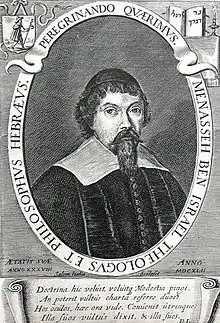Salom Italia
Salom Italia (also Salomo d'Italia) (ca. 1619, possibly Mantua - ca. 1655, possibly Amsterdam) was an Italian copper engraver who worked in Amsterdam. He became known particularly for his illustrations for the Book of Esther, which merged ideas about the Jewish diaspora with those of Dutch liberation after the Eighty Years' War.
Salom Italia | |
|---|---|
| Born | 1619 |
| Died | 1655 (aged 35–36) |
| Nationality | Dutch |
| Known for | Engraving |
Biography
Salom Italia was likely born ca. 1619 in Mantua, Lombardy, where his father Mordechai operated a printing house. Earlier suggestions, that he had been born in Castel Branco, were denied by Narkiss in 1957. Narkiss argues that he left Mantua after the Austrians invaded, and left for the Republic of Venice, and settled in Amsterdam at the latest in 1641, where he began work as an artist and where he likely worked until he died.[1]
He was one of only a few Jewish artists working in Amsterdam. Of the ten known works he signed, two are dated.[2] Most of his copper engravings pertain to the Book of Esther. He is known also for his portraits of the rabbis Jacob Judah Leon (1641, and another in 1647) and Menasse ben Israel (1642),[3][4] and for the Jewish marriage contracts he illustrated.
Esther scrolls

In Amsterdam, Italia developed a new way of illustrating the parchment scrolls that contained the Book of Esther, scrolls which were used during Purim—during those services, the text was read out loud, while congregants read along with their own copies. Italia's illustrations included triumphal arches, portraits of the main characters, and narrative scenes and vignettes against the backdrop of Dutch landscapes. They merged the Jewish diaspora and Jews' integration in the Dutch Republic with the (recent) Dutch experience of liberation from their Spanish overlords after the Eighty Years' War. Italia's scrolls were very popular at a time when the Esther story held considerable importance in the Netherlands; six of them were gathered for a 2011 exhibition in the Joods Historisch Museum in Amsterdam.[5]
Gallery
 Jacob Judah Leon
Jacob Judah Leon Menasseh ben Israel
Menasseh ben Israel
Literature
- M. Narkiss: The Oeuvre of the Jewish Engraver Salom Italia (1619–1655?). In: Tarbiz. 25, 1956, pp. 441–451; 26, 1957, pp. 87–101.
- Salli Kirschenstein: Juedische Graphiker aus der Zeit von 1625–1825. Berlin 1918.
- Narkiss, Bezalel (2007). "Italia, Shalom". Encyclopaedia Judaica. Vol. 10 (2 ed.). Detroit/New York. p. 787. ISBN 978-0-02-865938-1.
{{cite encyclopedia}}: CS1 maint: location missing publisher (link) - Assaf, Sharon; Bilski, Emily D., eds. (2011). Salom Italia's Esther scrolls and the Dutch Golden Age. Essay Series in Jewish Culture and Art. Vol. 1. Amsterdam: Joods Historisch Museum. ISBN 978-90-81586-03-0.
- Sabar, Shalom. "A New Discovery: The Earliest Illustrated Esther Scroll by Shalom Italia," Ars Judaica 8 (2012), pp. 119-136.
References
- Narkiss, M. (1956). "The Oeuvre of the Jewish Engraver Salom Italia (Conclusion)". Tarbiẕ: 87–101. JSTOR 23588702.
- Narkiss, EJ2.
- Zell, Michael (2002). Reframing Rembrandt: Jews and the Christian Image in Seventeenth-Century Amsterdam. University of California Press. p. 26. ISBN 9780520227415.
- Singer, Isidore; Adler, Cyrus, eds. (1916). The Jewish Encyclopedia: A Descriptive Record of the History, Religion, Literature, and Customs of the Jewish People from the Earliest Times to the Present Day. Vol. 5. Funk and Wagnalls. p. 175.
- "The Triumph of Identity: Salom Italia's Esterrollen en de Nederlandse Gouden Eeuw" (in Dutch). Joods Historisch Museum. Retrieved 24 October 2019.
External links
- Salom Italia articles at Joods Historisch Museum
- Esther Rolle im Jewish Museum New York.
- Ketubba im Israel Museum Jerusalem.